Car lights: led, halogen, xenon, laser and lights of the future
Here is how they work led, halogen, xenon, laser lights.
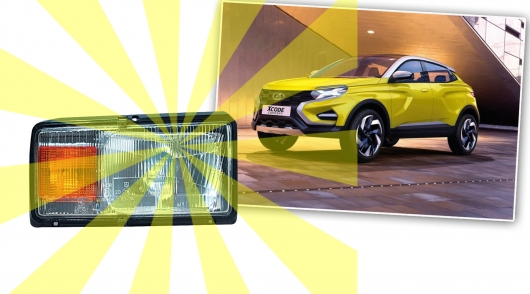
Thus, we consider in our article different types of car headlights and will explain to you how each technology works. In particular, we will introduce you to the future technology that will change the automotive optics beyond recognition.
At the dawn of the automotive industry car lights were simple: a light bulb with a reflective bowl and a glass lid – that’s the whole design of the front optics. But it was better than nothing. Despite the fact that the first lights had a small capacity, they somehow made the car visible on the road a little and also helped the driver to drive in the dark. However, driving in the dark out of the question. The first headlight was not able to provide proper illumination of the road.
Over time, the desire of motorists to see where they were going in the dark, led to the emergence of technologically advanced automotive headlights. We have witnessed the emergence of halogen optics. Then on the stage the automotive industry there was a xenon lamp that has made a huge leap in automotive lighting. But because automakers half a century looking for a way to make the car economical, the development of automotive optics is not stopped. In the end, replaced the xenon optics with lightweight bodies, engines, etc. came led optics, which in short time became popular all over the world.
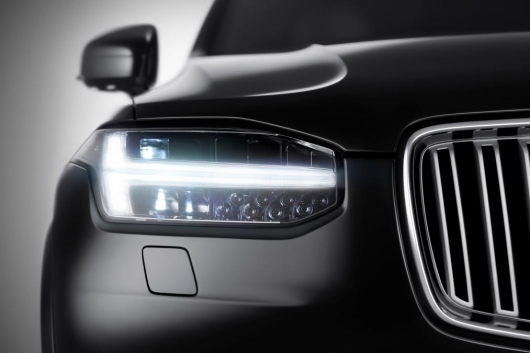
However, this technology of optics has not ceased to evolve. The use of light-emitting diodes began to develop. In the end, the world had a led matrix headlights, which are sometimes referred to as adaptive LED optics.
After that, Audi and BMW went even further, presenting the unique technology of laser headlights, which prompted the development of automotive optics in the future. I wonder how soon it will happen again the next breakthrough in this field? Who knows. It is possible that tomorrow will be a new technology of car lighting, which again will turn our view of automotive optics.
So now let’s consider all the options (types) headlights, which are already used in the automotive industry.
What type of headlight is best for you?
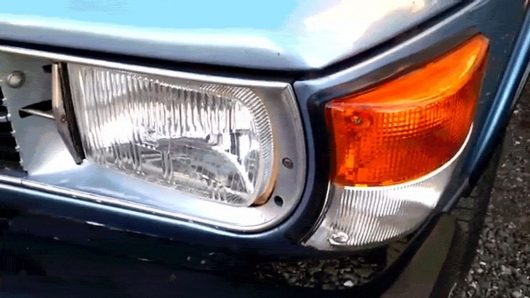
Below we sections will explain how each type of headlights that are used today in the auto world. Of course, every kind of automotive optics has its pros and cons. This is logical, since it is known that in the ideal world does not exist. Also you have to understand that not all drivers are like modern technology. For example, there are drivers who would not want to abandon the old reliable halogen lamps in favor of the same xenon or LEDs.
And what type of lamps you like? For example, many motorists scratching their heads before buying a car, deciding what type of lighting should be in the car. And then, of course, the dilemma is more complex. After all, our choice should depend not only some of the tastes and personal views, but also what’s more profitable: halogen, xenon or led?
Halogen bulbs are the oldest type of a light source in automotive headlamps. If you are looking for cheap and relatively reliable lights, then you should not worry about that halogen optics outdated compared to modern headlights. Halogen lighting in the car is time-tested and proved to be a pretty good side. Today cars with halogen headlamps are much cheaper than cars with hid or led optics.

However, halogen lights usually look outdated today. They just do not have the high-tech appearance, as well as more interesting options. Including halogen optics can’t compare to the quality of road lighting compared to hid or led headlights. But the main thing – halo cannot compete with more modern headlights on service life. Halogen lamps have a small lifetime in contrast to xenon or led bulbs.
On the other hand, the cost of xenon lamp significantly more than halogen. In addition to the xenon headlamps use electrical equipment, which eventually fails. Including there is a problem with the burning lens in optics, the replacement cost of which may be comparable to the cost of a new halogen headlight.
So led light sources, most likely, will soon retire not only halogen, but xenon.
Today, the car market presents a huge number of various led lights, from simple to the incredibly complex (and hence expensive for repair and replacement). The LEDs not only look modern. Based on them, the car manufacturers began to develop new types of automotive optics, presenting the Autoworld matrix and laser lights.

At the moment, matrix headlamps appeared only on premium cars, as this technology is still way. Matrix LED technology is based on combining LEDs with sensors that allows you to tailor the light rays for maximum coverage of the road ahead of the vehicle, taking into account oncoming traffic. In the end, this technology, in fact, sent far and dipped into retirement. Matrix headlights from the driver there is no need to choose which lighting to go (near, far). Automation itself decides how to illuminate the road.
And finally, the world now has laser headlights that offer better illumination capacity. But while they can be found only in a few new cars in the premium segment. The reason why laser lights has not yet appeared in normal cars is the cost of these lights, and the incredibly expensive cost of their repair/replacement (on some cars, the cost of one headlight may be 8000-10000 dollars). But the main problem of laser headlights is their fragility. For example, even with a small hit and crack the glass lights required complete replacement of the optics block.
So, once you’ve got the General idea about the types of lights in today’s automotive industry, let us now proceed to the description of each technology, so you can choose for yourself what optics. Here’s how each type of lights running.
What is halogen lights and how they work?
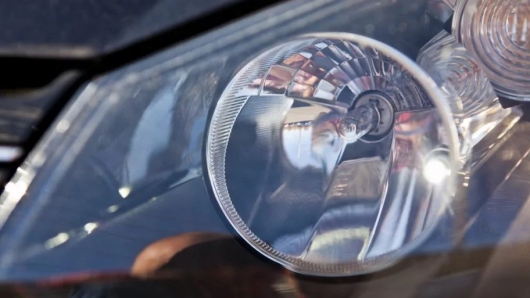
Halogen lights is named in honor of a group of elements (Halogens) that are used within them. So, in the halogen headlight bulb set, within which the injected gas halo, extending the service life of the tungsten filament. But still, compared to more modern light sources halogen lamp work for long.
But despite the longevity of halogen lamps, halogen lights have become popular not only in automotive, but in other industries. For example, halogen light sources for a long time (more than half a century) are massively used in homes, street lamps, etc.
Nevertheless, today the world stands on the threshold of a revolution in lighting. For example, in many countries, the use of halogen lighting in buildings is already prohibited due to low energy efficiency compared to energy saving and led lamps. But despite this, in the automotive industry halogen headlamps are still massively used in many cars. Although it is recognized that gradually they have been replaced by xenon and led optics.
As a working halogen bulb?

Galogenki is one of the oldest types of lamps that you can find today in cars. These bulbs work like a regular incandescent that we use at home. These bulbs are easy to the device: glass bulb, filament and gas. The filament is supplied with electricity, which, passing it through itself, starts to produce light (and, of course, the heat from the heating).
Halogen lamps are called as inside the glass bulbs used halogen gas, which prevents damage to the tungsten filament and also protects the glass from blackening due to the heat.
Halogen lamps: “for” and “against”
Pros
- Cheap
- Easy replacement in case of failure
Cons
- Low energy efficiency that affect the efficiency of the vehicle
- Low efficiency lighting
- Lower durability compared to xenon or led light sources
What is xenon headlights, and how do they work?

Xenon lights, like halogen, has received its name from the gas used inside the bulbs mounted in the headlights. However, the function of the gas in xenon lamps is different: the gas in xenon lamps is essential for the production of light, not in order to prolong the service life of the filament, as it is in halogen lamps with halogen gas.
How to operate a xenon bulb?
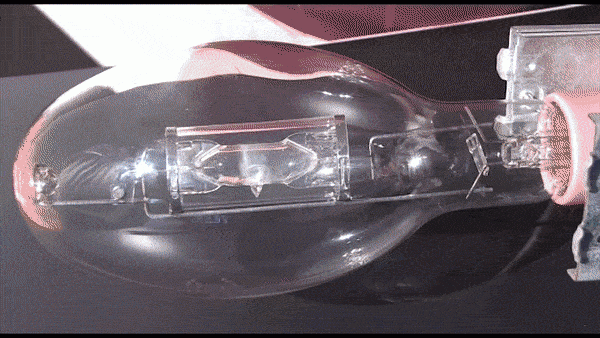
As mentioned above, the xenon lights are very different from halogen bulbs. Especially glow. You can easily recognize on-road cars with xenon bulbs by the characteristic blue color of light that generate xenon light sources.
Xenon bulbs use an electric arc between two electrodes and no filament as in halogen bulb. The xenon gas inside the bulb helps to establish an arc discharge between the electrodes (which creates light). Moreover, the electric arc glows at lower temperatures compared to halogen lamp.
In our country xenon light sources fall under strict regulation laws. So, at the moment of the xenon lamp can only be used in special car optics, which are designed for xenon light sources. Usually these headlights the vehicle manufacturer specifies a special marking.
Under current law, the use of xenon bulbs in headlights designed for halogen lights is prohibited. It provides for liability in the form of deprivation of rights.

However, any driver can install on your car instead of halogen bulbs xenon lights. For this you need to contact a specialized company engaged in the reworking of automotive headlights xenon.
Next, you will have to pass an examination for compliance with the vehicle’s security after making any changes to the vehicle, and then re-registered the car in the traffic police, after receiving the certificate of modification to the vehicle. Naturally, all this is expensive both in money and time.
Xenon: pros and cons
Pros
- Life. Xenon lamps can work up to 10 years, which makes their use very beneficial and effective
- Brightness. Lamps give light under heavy discharge
- Xenon is brighter than halogen counterparts
Cons
- Cost. If you buy a used car with xenon lamps, whose age is approaching 10 years, you have to remember that good original xenon bulbs are not as cheap as you think
- Not as energy efficient as led units
- Lamp fade with time (at least give a bright glow because of the gas combustion)
What are led lights and how they work?
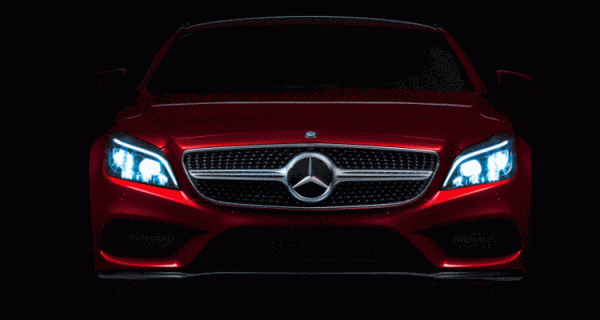
Most people know that LEDs are light sources based on light-emitting diodes, which have a number of advantages over halogen and xenon lamps. Including in the automotive industry. But few people think that LEDs compared with halogen lamps more expensive and difficult in the production process. However, LEDs are taking over the auto industry.
Why? It’s not only in bright light, but in their incredible energy efficiency due to the fact that each used a diode in the headlight consumes much less energy compared to halogen or xenon light sources.
Most new cars today are equipped with led daytime running lights. With regards to full led headlamps, while what in the world LED lights have become the global standard. Nevertheless every year more and more cars get in the base set of full led headlights. In the future, most likely, all cars (even cheap ones) are only supplied with LEDs.
Manufacturers, rigging machine LED lights and have the same goal – reducing fuel consumption and reducing harmful emissions. When using led light sources in the vehicle decreases the load on the electrical circuit. That’s why LEDs are becoming popular worldwide.
The LEDs also produce a crystal clear light. The new generation of matrix headlamps allowed us to achieve huge success in the adaptation of automotive lighting depending on the road conditions. This is a huge step forward compared to halogen, xenon led and normal headlamps. The only negative of the matrix of lights is incredibly expensive to replace the optics in case of damage or breakage.
How to operate led lights?

Led is just a semiconductor that emits light when it passes through the shock. In order for the semiconductor started to glow, you need a negligible amount of electricity. Due to the fact that the LEDs need little energy, the battery to maintain lighting consumes much less energy compared to halogen or xenon lamps. Therefore, the less energy is consumed, the less is the load on the engine to charge the battery, which ultimately affects the efficiency of the vehicle.
The current in the led headlights flows from the cathode to the anode, passing through the semiconductor material, which conduction is a something between metal and rubber. In the end, the semiconductor with the passage of electricity begins to emit photons, which illuminate the road ahead of the vehicle.
Due to the simplicity of design led service life can last more than ten years. However, led headlamps – yet new technology. And how it works, time will tell. Unfortunately, there is no 10-year-old car with led optics, which would allow to conclude about the real lifespan of led lights. Indeed, in contrast to household led bulbs LED lights in the car are under constant shaking, vibration, temperature extremes, etc. And who knows how long will be the LEDs in the car. It is possible that their reliability will be in doubt.
What is adaptive led headlights?
It should be noted that not all adaptive headlights are adaptive led units. Adaptive led unit is a headlamp that can change the direction and/or brightness in accordance with the road conditions by changing the order of the LEDs in the block and by changing their brightness.
What is the led matrix bulb (Matrix) and how they work?

In mathematics, a matrix is defined as a rectangular array of numbers organized in rows and columns that are treated as a single object. Change the “numbers” on “LEDs and sensors” in this definition and you will get a matrix concept in automotive lighting.
Led matrix lights are paired with sensors and cameras that come with the car.
All these sensors and cameras monitor the road ahead to determine traffic and changed road conditions (e.g., sharp turns).
All this data is used for intelligent road lighting by controlling lighting of each led in the matrix. But the ultimate goal matrix lights save as much light as possible without harm oncoming traffic.
Led lights: pros and cons
Pros
- Energy-efficient light sources
- Can be relatively inexpensive
- Long-term predictable service life
Cons
- Can be very complex
- Can be very expensive to repair
- New led headlamps are very expensive
Future lights

Currently a number of automotive companies did not stop on the conventional and matrix led headlights, developing and popularizing new type of automotive optics. We are talking about laser and digital light sources.
For example, a leader in the field of laser lamps is the BMW, which is already at its high-tech i8 hypercare offers laser headlights. But BMW is not alone in the auto world. For example, Audi has also decided on the supercar R8 LMX to install laser lights of his own design.
How laser lights work?
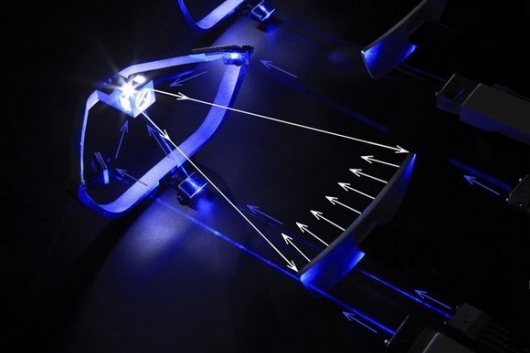
Laser light sources work by firing a laser on a phosphor, which emits light. Released light is then filtered by passing it through a special lens. Then the photons reflected from the reflector and be on the road ahead of the vehicle.
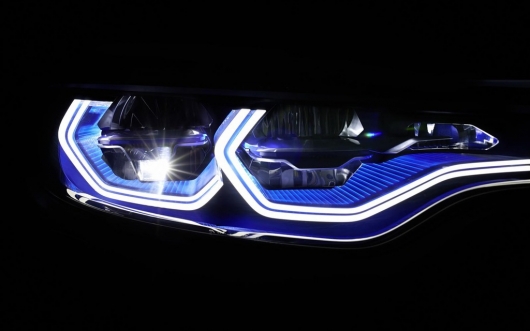
Unlike the first generation of laser headlights, which came with one large reflective bowl, today, automakers began to use optics design of hundreds of tiny custom mirrors that allow the vehicle electronics to precisely which areas of the road ahead of the machine should be lit. This means that modern laser lights become adaptive.
Digital lights – two steps ahead
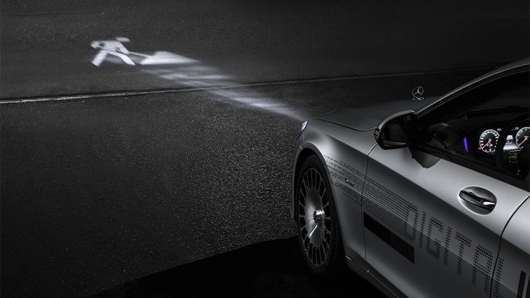
While in the world uses halogen, xenon, led and matrix laser lights, Mercedes are currently working on something more interesting and futuristic. We are talking about headlight technology, called “Digital Light”. And today this technology is about to begin appearing in production cars Mercedes. For example, we already know that this option will be in the new S-class.
We are talking about projecting into the road ahead of the vehicle for various valuable driver information. For example, lights can be projected directly in front of the vehicle information about the missing road sign or warn the driver about the pedestrian crossing.
Including the road could be projected a lot of warnings electronics.
